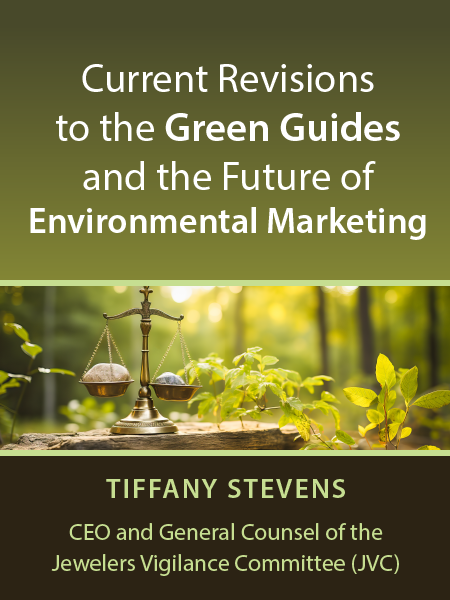
With the ever-increasing importance of climate change to consumers, more and more companies are touting their beneficial environmental impact as a form of marketing. The Federal Trade Commission (FTC) does its part to regulate these claims under the framework of their so-called Green Guides, which provide guidelines for marketing “green” claims about eco-friendly, sustainable, ethical, recycled, and all other similar terms to the US consumer.
This article will review the Green Guides as they stand and where they might be going, both generally and from the perspective of the world of jewelry. Jewelry has outperformed all other luxury verticals and most other retail verticals over the past three years ascending in relevance and bottom-line importance to many companies. But jewelry can be a complex trade and there are special considerations to take into account before advising clients who have significant jewelry activity in their company.
What are the Green Guides?
First issued in 1992 to help companies avoid making misleading environmental claims in their marketing materials, Guides for the Use of Environmental Marketing Claims (Green Guides) were subsequently revised in 1996, 1998, and 2012.1 In December 2022, the FTC sought public comments on potential updates with new Guides being issued likely in 2024.2
The Green Guides cover a wide range of industries and are intended to help marketers and advertisers avoid making environmental claims that could mislead consumers. Although the Green Guides are just that—guidelines—they draw their authority from Section 5 of the Federal Trade Commission Act (FTCA) which prohibits ‘’unfair or deceptive acts or practices in or affecting commerce.”3 Violation of the Green Guides can (and does) result in all manner of penalty and enforcement by the FTC.
In general, an advertisement is deceptive if it contains a representation or omission of fact that is likely to mislead a reasonable consumer and was material to a consumer’s purchasing decision. Advertising claims must provide adequate disclosures that must be conspicuous and obvious to the average American. This disclosure must be made on all digital platforms and in print or in person in a plainly obvious and easy to understand manner.
For example, The Green Guides advise that marketers should not make “unqualified” or unsubstantiated general environmental benefit claims (e.g., the brand name “Eco-friendly”).4 Qualified claims (e.g., “greener than our previous packaging”) should be substantiated and accompanied with specific language (e.g., “We’ve reduced the weight of our packing by 15 percent”). The Green Guides also provide guidance on environmental terms, such as “compostable,” “non-toxic,” and “recyclable”5 as well as claims about carbon offsets.6
The FTC has initiated enforcement actions—from warning letters to federal lawsuits—against companies for deceptive practices, resulting in monetary penalties and other equitable relief, such as prohibitions on making deceptive green claims or using other misleading advertising. Recent examples of FTC enforcement actions include:
- In 2022, the FTC sued Kohl’s, Inc. and Walmart, Inc. for: (i) falsely marketing rayon products as bamboo; and (ii) making deceptive environmental claims that the bamboo textiles were ecofriendly, while in reality converting bamboo into rayon involved toxic chemicals and hazardous pollutants. The settlements prohibited the companies from making deceptive green claims or using other misleading advertising and required them to pay penalties of $2.5 million and $3 million, respectively.7
- In 2019, a judge ordered Lights of America to pay $21 million to the FTC for making false claims about the energy efficiency of its LED lightbulbs.8
- In 2018, Truly Organic Inc. and its CEO, Maxx Harley Appelman, agreed to pay $1.76 million to settle an FTC complaint alleging that their nationally-marketed bath and beauty products were neither “100% organic” nor “certified organic” by the US Department of Agriculture (USDA).9
CLICK HERE to read the full article, which was originally published in ALI CLE’s The Practical Lawyer.
The Practical Lawyer

Subscribe to the print or digital version of The Practical Lawyer today.
